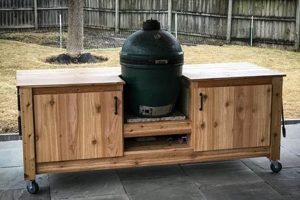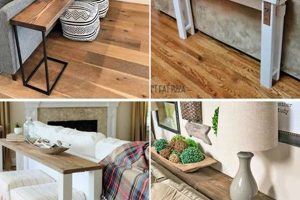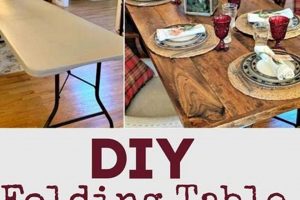A slender furnishing placed against the back of a couch provides a functional surface for lamps, decor, or refreshments in a living space. Frequently constructed by individuals to customize its dimensions, style, and finish, this narrow console augments the usability and aesthetics of a seating arrangement.
Such projects offer an opportunity to maximize space utilization, particularly in smaller rooms, and can serve as a decorative focal point. Construction allows for tailored solutions to match existing decor and prevent items from falling behind the sofa. Historically, individuals have crafted furniture to meet specific needs and express personal style, resulting in unique pieces that reflect resourcefulness and creativity.
The subsequent sections will delve into various aspects of building this functional item, including design considerations, material selection, step-by-step construction techniques, and finishing options, providing a guide for crafting personalized home enhancements.
Construction Guidance
The following guidance provides critical considerations for successfully building this project. Adhering to these recommendations enhances the final product’s utility, appearance, and longevity.
Tip 1: Precise Measurement: Before commencing construction, accurately measure the available space behind the sofa. Consider sofa height, back angle, and desired table overhang to ensure a seamless fit and prevent obstructions.
Tip 2: Material Selection: Choose lumber based on desired aesthetic and structural requirements. Hardwoods offer durability and visual appeal, while softwoods are more cost-effective but may require additional reinforcement. Select appropriate fasteners based on material type and joint strength requirements.
Tip 3: Structural Integrity: Employ robust joinery techniques, such as mortise and tenon, dowel joints, or pocket screws, to ensure structural stability. Reinforce stress points with corner braces or gussets to prevent wobbling or collapse.
Tip 4: Surface Preparation: Thoroughly sand all surfaces with progressively finer grits of sandpaper to create a smooth and even base for finishing. Remove dust with a tack cloth prior to applying any finish.
Tip 5: Finishing Application: Select a finish appropriate for the chosen material and intended use. Polyurethane provides a durable, water-resistant surface, while stain allows for customization of wood tone. Apply multiple thin coats for optimal coverage and protection.
Tip 6: Cord Management: Integrate cord management solutions, such as pre-drilled holes or cable clips, to neatly conceal electrical cords and prevent tripping hazards. Plan cord routing prior to assembly to ensure accessibility.
Tip 7: Weight Distribution: Design the structure to evenly distribute weight across the base. Consider adding additional supports or a wider footprint to prevent tipping, especially if heavy items will be placed on the surface.
By carefully considering these factors, individuals can build a sturdy, attractive, and functional piece that seamlessly integrates into the existing living space, enhancing its usability and aesthetic value.
The following section will cover common mistakes to avoid when undertaking this project and offer troubleshooting solutions for potential challenges.
1. Measurements
Accurate dimensions are paramount to the successful construction of a table designed for placement behind a sofa. Imprecise measurements can lead to a final product that is either functionally inadequate or aesthetically displeasing within the intended living space.
- Sofa Height and Back Angle
Determining the precise height of the sofa’s backrest is crucial for ensuring the table’s surface aligns appropriately. A table that is too low may be functionally useless, while one that is too high can obstruct the user’s view or create an unbalanced aesthetic. Similarly, accounting for the sofa’s back angle is vital for achieving a flush fit against the furniture.
- Available Space Behind Sofa
Before commencing any construction, measuring the available depth between the sofa and the wall is essential. This measurement dictates the maximum width of the tabletop, preventing the table from protruding excessively into the room. Careful consideration of this dimension maximizes available space and ensures ease of movement within the living area.
- Leg Placement and Overhang
The placement of the table legs is directly influenced by the sofa’s dimensions and the desired level of overhang. The legs must be positioned to provide stable support without interfering with the sofa’s structure or creating an unstable base. Precise measurements ensure balanced weight distribution and prevent potential tipping.
- Electrical Outlet Proximity
Incorporate measurements related to electrical outlet locations if the table is intended to house lamps or charging devices. This allows for strategic placement of cord management solutions, such as grommets or channels, to conceal wires and prevent tripping hazards. Accurate measurements in this regard contribute to both safety and aesthetic appeal.
These measurement considerations underscore the importance of meticulous planning in the creation of a functional and visually harmonious behind-sofa table. Accurate dimensions translate directly into a piece that seamlessly integrates into the living space, enhancing both its utility and aesthetic appeal.
2. Material Choice
The selection of appropriate materials directly impacts the structural integrity, aesthetic appeal, and overall longevity of a behind-sofa table. Material choice influences factors such as weight capacity, resistance to wear and tear, and the style it projects within a living space. For example, using solid hardwoods like oak or maple yields a robust structure capable of supporting significant weight, suitable for accommodating lamps, books, or decorative items. Conversely, employing lightweight materials such as pine or MDF might compromise stability, particularly if the table is intended to bear heavy loads. The material’s susceptibility to scratches, dents, and moisture also dictates its long-term appearance and maintenance requirements.
The chosen material dictates the construction techniques required and the necessary finishing processes. Hardwoods often necessitate more specialized tools and joinery methods compared to softwoods. The finish applied to the table must be compatible with the selected material to ensure proper adhesion and protection. Stain, paint, varnish, and sealant options vary in their suitability depending on whether the table is crafted from wood, metal, or composite materials. A poorly chosen finish can lead to peeling, cracking, or discoloration, compromising the table’s aesthetic appeal and protective qualities. Cost considerations often influence the decision-making process; budget limitations may necessitate selecting alternative materials that offer a balance of affordability and acceptable performance.
Therefore, careful evaluation of material properties is paramount when undertaking such projects. Factors such as structural requirements, aesthetic preferences, budget constraints, and the intended function of the completed table directly impact the selection process. An informed material choice ensures the construction of a durable, visually appealing, and functionally appropriate addition to the living space. Challenges might include balancing cost considerations with desired durability or aesthetic qualities, requiring a thorough understanding of material properties and construction techniques.
3. Joint Strength
The structural integrity of a behind-sofa table is intrinsically linked to the strength of its joinery. Adequate joint strength ensures the table can withstand the stresses of regular use, prevent premature failure, and maintain stability over time. The choice of joinery techniques and their execution are therefore critical considerations in the design and construction process.
- Types of Joints and Their Load-Bearing Capacity
Various joint types, such as mortise and tenon, dowel joints, pocket screws, and butt joints, exhibit different levels of load-bearing capacity. Mortise and tenon joints, known for their robust interlocking nature, are suitable for load-bearing applications. Dowel joints, while offering moderate strength, can be reinforced with adhesives. Pocket screws provide ease of assembly but may require supplementary support for heavier loads. Butt joints, the simplest form, are generally inadequate for structural components in such a table without significant reinforcement. Selecting a joint appropriate for the intended load is essential for long-term durability.
- Impact of Material Selection on Joint Strength
The type of material used in construction significantly affects the potential strength of a joint. Hardwoods, possessing higher density and tensile strength, offer superior holding power for fasteners and adhesives compared to softwoods. Composite materials, such as MDF or plywood, exhibit varying degrees of joint strength depending on their composition and construction. Matching the joint type to the material properties optimizes the connection’s overall strength.
- Role of Adhesives and Fasteners
Adhesives and fasteners play a crucial role in enhancing joint strength. High-quality wood glues, when properly applied, create bonds that often exceed the strength of the wood itself. Fasteners, such as screws and nails, provide mechanical reinforcement and prevent joint separation. The choice of adhesive and fastener type should be compatible with the materials being joined to ensure optimal bonding and holding power. Proper application techniques are equally important for achieving maximum joint strength.
- Consequences of Joint Failure
Failure of a joint within a behind-sofa table can lead to structural instability, resulting in wobbling, sagging, or complete collapse. Joint failure not only compromises the functionality of the table but also presents a potential safety hazard. Reinforcing joints with corner braces or gussets can mitigate the risk of failure, particularly in areas subjected to high stress. Regular inspection of joints for signs of weakness or damage is recommended to prevent catastrophic failure.
The careful selection and execution of appropriate joinery techniques, in conjunction with compatible materials and reinforcing elements, are paramount for creating a durable and stable behind-sofa table. Prioritizing joint strength ensures the table can withstand the rigors of daily use and provide lasting functionality within the living space.
4. Surface Finish
The application of a surface finish is a critical step in the construction of a behind-sofa table. It significantly impacts the aesthetic appeal, durability, and overall functionality of the piece, providing protection against wear, moisture, and environmental factors.
- Aesthetic Enhancement
The choice of surface finish directly influences the visual characteristics of the table. Stains alter the wood tone, enhancing the natural grain or achieving a desired color. Paints provide opaque coverage, allowing for a wider range of color options and design styles. Clear finishes, such as varnish or lacquer, highlight the wood’s inherent beauty while offering protection. The selection of a finish that complements the existing decor and personal preferences is paramount in achieving a cohesive aesthetic within the living space.
- Protection Against Wear and Tear
Surface finishes act as a protective barrier against everyday wear and tear, including scratches, dents, and abrasions. Durable finishes, such as polyurethane, provide a robust layer of defense, extending the lifespan of the table. Finishes also protect against moisture, preventing water damage, warping, and decay. Selecting a finish appropriate for the table’s intended use and the potential exposure to environmental factors is crucial for maintaining its appearance and structural integrity over time.
- Ease of Maintenance
Certain surface finishes simplify cleaning and maintenance, making it easier to remove spills, dust, and other contaminants. Smooth, non-porous finishes are particularly easy to wipe clean, preventing stains from penetrating the material. Finishes that are resistant to chemicals and household cleaners ensure that the table can be cleaned without damaging the surface. Selecting a finish that aligns with the desired level of maintenance is an important consideration for ensuring the long-term upkeep of the table.
- Application Techniques and Considerations
The successful application of a surface finish requires careful attention to detail and adherence to proper techniques. Surface preparation, including sanding and cleaning, is essential for achieving a smooth and even finish. Multiple thin coats are generally preferred over a single thick coat to prevent runs, drips, and uneven coverage. Proper ventilation and safety precautions are necessary when working with certain finishes, particularly those containing volatile organic compounds (VOCs). The application process significantly impacts the final appearance and performance of the finish.
The selection and application of a surface finish represent a crucial element in the overall construction of the behind-sofa table. A well-chosen and properly applied finish enhances the table’s aesthetic appeal, provides essential protection against wear and tear, simplifies maintenance, and contributes to its long-term durability. The success of the finishing process directly influences the overall quality and longevity of the completed project.
5. Cord Management
The incorporation of effective cord management strategies is a crucial aspect of designing and constructing a behind-sofa table. Addressing this element enhances the functionality, safety, and aesthetic appeal of the finished piece, preventing unsightly clutter and potential hazards.
- Aesthetic Enhancement via Concealment
Exposed cords detract from the visual appeal of a living space. Integrating cord management solutions allows for the concealment of cables associated with lamps, charging devices, or other electronics. Concealment methods include pre-drilled holes, strategically placed grommets, and internal channels designed to route wires discreetly. A tidy appearance contributes to a more organized and inviting environment.
- Safety Considerations and Hazard Prevention
Unmanaged cords pose a tripping hazard and can create a risk of electrical shock if damaged or frayed. Securing cords and preventing them from dangling or lying across walkways minimizes these risks. Cord management systems also help to prevent cords from becoming entangled or pinched, reducing the likelihood of damage and potential fire hazards. Prioritizing safety is a fundamental aspect of responsible design.
- Accessibility and Functionality
While concealing cords is desirable, maintaining accessibility for device charging and adjustments is equally important. Cord management solutions should allow for easy access to outlets and ports, facilitating the connection and disconnection of devices as needed. Incorporating features such as removable panels or access points ensures that cords can be managed without requiring disassembly of the table.
- Integration with Table Design and Construction
Effective cord management is best achieved when integrated into the initial design and construction phases. Planning the location of cord management features prior to assembly allows for seamless integration and avoids the need for modifications after completion. Considerations include the size and placement of holes, the routing of internal channels, and the provision of adequate space for accommodating multiple cords. Thoughtful planning optimizes both functionality and aesthetics.
The successful incorporation of cord management solutions in the construction of a behind-sofa table elevates its functionality and aesthetic value, contributing to a safer and more organized living space. Careful planning and execution of these elements are essential for achieving a polished and practical final product. Challenges might include finding appropriate solutions to manage a large number of cables, or to seamlessly integrate cord management in pre-existing furniture.
6. Stability
The inherent stability of a behind-sofa table is paramount to its functionality and safety. A structurally unsound table presents a tipping hazard, limits its utility, and diminishes the overall aesthetic of the living space. The following facets explore the crucial elements contributing to the stability of such a table.
- Base Dimensions and Weight Distribution
The width and depth of the table’s base directly correlate with its stability. A wider base provides a lower center of gravity, mitigating the risk of tipping, particularly when weight is unevenly distributed on the tabletop. The placement of legs or supporting structures should be carefully considered to ensure balanced weight distribution. Examples include splaying the legs outward or incorporating a solid base panel to increase surface area contact with the floor. Insufficient base dimensions compromise stability, rendering the table prone to toppling under normal use.
- Material Selection and Structural Rigidity
The choice of materials significantly impacts the table’s overall rigidity and resistance to deformation. Solid hardwoods offer greater stiffness and load-bearing capacity compared to softer woods or composite materials. Proper joinery techniques, such as mortise and tenon joints or reinforced screw connections, enhance the structural integrity and prevent wobbling or sagging. Insufficient material strength or inadequate joinery compromises stability, leading to structural failure under moderate loads.
- Height and Center of Gravity
The height of the table influences its center of gravity. A taller table with a higher center of gravity is inherently less stable than a shorter table with a lower center of gravity, given a consistent base dimension. Tall, narrow tables are particularly susceptible to tipping, especially when loaded with heavy objects. Careful consideration of the table’s height in relation to its base dimensions is crucial for maintaining stability and preventing accidental tipping.
- Floor Surface and Leveling Considerations
The type of flooring on which the table rests can affect its stability. Uneven or carpeted surfaces can introduce instability, particularly if the table’s legs are not properly leveled. Incorporating adjustable feet or shims allows for leveling the table on uneven surfaces, ensuring a stable and secure base. Failure to address floor surface irregularities compromises stability, potentially leading to wobbling or tipping.
These facets underscore the importance of prioritizing stability in the design and construction of a behind-sofa table. By carefully considering base dimensions, material selection, height, and floor surface conditions, individuals can create a structurally sound and safe addition to their living space. Conversely, neglecting these factors can result in a table that is both functionally limited and potentially hazardous.
7. Style Harmony
Style harmony, in the context of constructing a behind-sofa table, refers to the cohesive integration of the new piece with the existing aesthetic elements of the living space. The cause-and-effect relationship is straightforward: careful consideration of style harmony results in a finished product that enhances the room’s overall visual appeal, while neglecting this factor can lead to a discordant and visually jarring addition. Its importance stems from the fact that a behind-sofa table is not merely a functional object but also a visible element contributing to the room’s ambiance. For example, a rustic-style table crafted from reclaimed wood would complement a farmhouse-themed living room, whereas a sleek, minimalist table made of metal and glass would align with a contemporary setting. Without style harmony, the table may appear out of place, detracting from the intended design.
The practical significance of understanding style harmony lies in its direct impact on the perceived value and enjoyment of the living space. Selecting materials, finishes, and design elements that echo existing furniture, color schemes, and architectural details is essential. This includes considering the sofa’s upholstery, the room’s wall color, and the presence of other decorative items. If the living room features mid-century modern furniture with clean lines and warm wood tones, the console behind the sofa must reflect those characteristics by featuring minimalist design and the use of similar wood species. Conversely, a Victorian-era living room calls for a more elaborate table with ornate detailing and perhaps a darker wood stain. Furthermore, style harmony goes beyond mere visual matching; it involves a sensitivity to the overall atmosphere of the room, such as whether the space is intended to feel cozy and inviting or sleek and sophisticated.
In conclusion, style harmony is a fundamental component of successfully integrating a behind-sofa table into an existing living space. While functional considerations are undoubtedly important, neglecting the aesthetic dimension can result in a piece that diminishes the room’s overall appeal. By consciously aligning the table’s design with the existing style elements, individuals can ensure that their new furniture enhances the spaces aesthetic value, creating a cohesive and visually pleasing environment. The challenges in achieving style harmony lie in accurately identifying the existing style and possessing the design skills to effectively translate that aesthetic into the finished piece. Mastering these challenges results in a truly integrated and valuable addition to the home.
Frequently Asked Questions
The following questions address common inquiries and misconceptions concerning the design, construction, and implementation of a behind-sofa table, offering clarity for individuals undertaking such projects.
Question 1: What is the standard height for such a table?
The optimal height generally aligns with the height of the sofa’s backrest, typically ranging from 24 to 32 inches. Accurate measurement of the sofa is paramount to ensure a seamless visual and functional integration.
Question 2: What are the recommended materials for ensuring structural stability?
Solid hardwoods, such as oak or maple, offer superior strength and durability. Softwoods, like pine, can be utilized but may require additional reinforcement to mitigate potential structural weaknesses.
Question 3: How can cord management be effectively integrated into the design?
Pre-drilled holes, strategically placed grommets, and internal channels provide efficient pathways for concealing and organizing electrical cords, minimizing visual clutter and potential safety hazards.
Question 4: What joinery techniques are best suited for achieving robust connections?
Mortise and tenon joints, dowel joints, and pocket screws offer varying degrees of strength and ease of assembly. The selection of the appropriate joint depends on the material type and the anticipated load-bearing requirements.
Question 5: How should the table’s finish be selected to ensure longevity and aesthetic appeal?
The choice of finish depends on the material and desired aesthetic. Polyurethane provides a durable, water-resistant surface, while stains enhance the wood’s natural grain. Thorough surface preparation is essential for optimal adhesion and a uniform appearance.
Question 6: What measures can be taken to prevent the table from tipping or wobbling?
A wide base, strategically placed legs, and the incorporation of leveling feet contribute to enhanced stability. Distributing weight evenly across the surface also minimizes the risk of tipping, especially when loaded with heavy objects.
These FAQs provide a concise overview of critical considerations for planning and executing the construction of a behind-sofa table. Addressing these points proactively contributes to a successful and satisfying project outcome.
The subsequent section will explore potential design variations and customization options for creating a unique and personalized table.
DIY Behind Sofa Table
This exploration has traversed critical aspects of designing and constructing a “diy behind sofa table,” from measurement precision and material selection to joint strength, surface finishing, cord management, stability considerations, and stylistic harmony. Each element profoundly influences the functionality, longevity, and aesthetic integration of the final product within the intended living space.
The construction of a “diy behind sofa table” transcends mere assembly; it represents a thoughtful engagement with form and function. Individuals are encouraged to apply the presented principles, adapting designs to meet unique spatial needs and personal aesthetic preferences. The resulting creations will not only enhance the usability of living spaces but also serve as tangible expressions of individual craftsmanship and design sensibilities.







